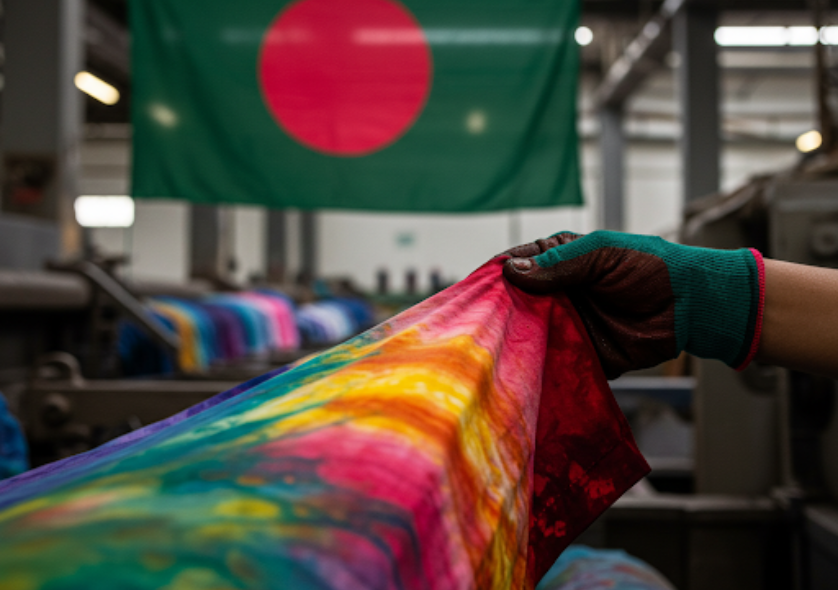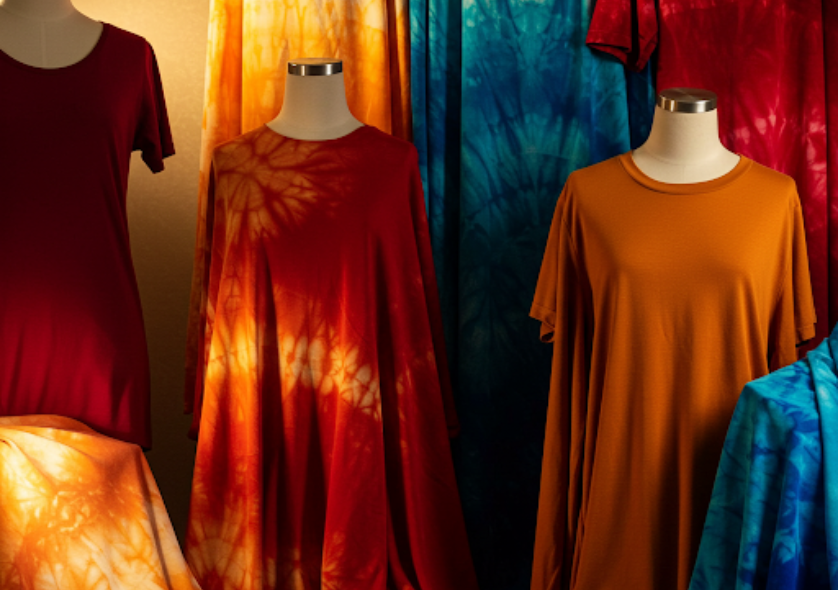Uncover the harmful effects of Azo dyes in textiles: cancer risks, skin allergies, and environmental damage. Learn how synthetic dyes impact health, ecosystems, and workers in the fashion industry. Explore eco-friendly alternatives and sustainable fashion solutions.
By Govind Singh Rathore
| Table of Contents 1. Introduction 2. What are Azo Dyes? 3. Azo Dyes and Cancer Risks 4. Chemical Dyes Affecting the Body 5. The Environmental Impact of Chemical Dyes 6. The Bangladesh Textile Industry 7. Conclusion |
Introduction
Could you have ever imagined that your favorite brightly colored dress could be a silent killer? Sounds a bit dramatic, right? But the truth is unsettling—the dyes and coloring agents that make your dress lively are not so full of life. Most of the dyes used for modern textiles today contain harmful chemicals and toxic substances. One of the most common among them is Azo dye. Azo dyes are among the most commonly used synthetic dyes, but they have been found to directly cause severe health concerns, including cancer, skin disorders, and environmental pollution. While these dyes make fashion comparatively cheaper and also keep colors from fading, we can’t just ignore the potential harm they cause. This article explores the negative impact of Azo and other chemical dyes on human health and the environment, shedding light on the dark side of the fashion industry.
What are Azo Dyes?
Azo dyes are a type of synthetic dye widely used in industries like textiles and food. They are the most commonly used dyes and account for about 60%-70% of dyes used in the industry. The reason for their widespread prevalence is the ease with which they can be produced in labs. By altering the chemical bonding structure of the compound, they yield all possible vibrant color combinations and also provide long-lasting, stable, and bright colors. But behind their usefulness lies the dark reality.
Many azo dyes contain carcinogenic aromatic compounds such as benzidine and toluidine, which are known to cause cancer in humans. They also contain heavy metals like cadmium, lead, and chromium that can accumulate in the body, damaging vital organs. For industry workers, the frequent inhalation of dye particles causes increased risks of asthma and lung problems.
The Prevalence of Chemical Dyes in the Textile Industry
The modern textile industry relies heavily on synthetic dyes due to their affordability and ease of manufacturing. They are found in everything; from everyday clothing to luxury fabrics, synthetic dyes have taken over the entire textile industry. Some reasons for their extensive use are:
- Cost-effectiveness: Synthetic dyes are comparatively very easy to mass produce. As the fashion industry’s demand grows continuously every day, using natural dyes becomes laborious and inefficient. So, chemical dyes become a very affordable alternative for manufacturers and consumers.
- Wide Range of Colors: These dyes can be produced with a multitude of different shades of every color, giving the textile industry more flexibility in designs and serving varied customer demands.
- Consistency and Quality: Synthetic dyes are manufactured in industry and in controlled environments, making them resilient. Any shade can be reproduced with high accuracy, while matching shades in natural dyes is difficult.
Azo Dyes and Cancer Risks
The most alarming danger of Azo and synthetic dyes is their potential to cause cancer. They are known to release carcinogenic substances, particularly aromatic amines, during their breakdown or metabolism. They are known to enter the human system through skin contact, inhalation, or ingestion. It not only affects the consumers or people wearing azo-dyed clothes but also the manufacturers and factory workers. Some of the major hazards of these dyes are as follows:
- Carcinogenicity: The International Agency for Research on Cancer (IARC) has identified certain Azo dyes to be human carcinogens. Multiple studies have linked long-term exposure to these dyes to an increased risk of bladder cancer. [Link to IARC studies on Azo dyes]
- Bioaccumulation: Aromatic amines released by Azo dyes can accumulate in the body and won’t just leave. They are known to be absorbed and get collected in cells and tissue in our body.
- Occupational hazards: Workers in the synthetic dyes industry have an increased risk of developing respiratory diseases, skin disorders, and cancer due to chronic exposure to toxic chemicals.
Chemical Dyes Affecting the Body

These toxic dyes not only pose an internal health risk but also affect the outer body. Synthetic dyes most frequently come in contact with the largest organ of the body, i.e., the skin, making it an easily accessible target. Prolonged exposure to these chemical dyes, particularly azo dyes and synthetic colorants, has been found to cause various dermatological conditions, ranging from mild irritation to chronic skin disorders.
- Allergic Reactions and Contact Dermatitis: One of the most frequent effects of wearing clothes dyed with toxic dyes is getting an allergic reaction or contact dermatitis, where the skin immediately reacts on coming in contact with a possible allergen. Some common reactions are rashes, itching, and inflammation.
- Severe Skin Issues and Chronic Dermatitis: Repeated contact with these substances can cause severe conditions like chronic dermatitis, which is a condition that causes dry and thickened skin patches that are often lichenified.
- Photosensitivity and Increased Sun Damage: It might sound not directly related to synthetic dyes, but they cause photosensitivity, a condition where the skin becomes intolerant of sunlight and causes redness and itching. Azo dyes contain pigments that react with the UV rays from sunlight and cause rashes, sunburn, and pigmentation.
A study of textile workers found that almost the majority of them suffered from skin irritation, with symptoms like itching, dryness, burning sensations, and cracks in the skin.
The Environmental Impact of Chemical Dyes
These chemical dyes also extend to harm beyond human health—they are terrible for the environment. Starting from the production to the disposal of synthetic dyes, all contribute to polluting and damaging ecosystems.
Major environmental concerns include:
- Water contamination: The textile dyeing industry is one of the largest contributors to water pollution across the globe. These industries and plants dump tons of untreated and poorly treated wastewater into local water bodies with untreated dye effluents that poison entire rivers and lakes, killing life in them.
- Harm to aquatic life: Most of the synthetic dyes are non-biodegradable; hence, they remain in the water bodies and kill fish and other aquatic life. Another harmful phenomenon of eutrophication, or the excess algae growth in water bodies or algal bloom, is caused by the accumulation of toxins and waste from industries rich in nitrogen.
- Soil Contamination: Synthetic and Azo dyes are not only disposed of in water bodies but also end up on land where they seep into the soil, where they both contaminate the soil and harm vegetation as well as pollute the groundwater by seeping into the groundwater reservoirs. Most of the chemical dyes contain corrosive and accumulating chemicals, meaning they persist in the environment for years, altering soil composition and making it unsuitable for vegetation and even for farming. In recent years, many farmers have reported significant declines in their crop yields due to the toxic buildup of dyes and industrial chemicals in the agricultural land.
- Air Pollution: Dye manufacturing industries and textile industries release harmful Volatile Organic Compounds (VOCs) and other dangerous gases directly into the air. Acid rain, which is not a very ancient phenomenon, occurs due to the excess amount of acidic gases in the atmosphere and has adverse effects on flora and fauna, water bodies, and even human health. Additionally, the burning of these chemicals and azo-dyed textile waste releases toxic fumes that contribute to air pollution and climate change.
Case Study: The Bangladesh Textile Industry

Bangladesh ranks among the top garment exporters worldwide; it’s known infamously for manufacturing clothing for major global and luxury brands. Yet, beneath the extensive industry, a grave health crisis affects workers and nearby communities because of their contact with synthetic dyes such as azo dyes and colorants that contain heavy metals and toxic substances.
The hidden health effects on workers in these industries include:
- Skin Diseases and Allergic Reactions: These workers frequently develop rashes, blisters, and long-term skin inflammation from coming in contact with toxic chemicals. This happens because they work many hours with fabric soaked in synthetic dyes without proper protection and safety measures due to a lack of awareness and available resources.
- Higher Cancer Risk: Workers who have been dealing with these chemicals for long periods stand a much higher chance of getting bladder and liver cancer. A study in Dhaka’s industrial areas found more cancer cases among the textile industry workers than the general public.
- Toxic Water Causing Gut and Kidney Problems: Villages near major industrial centers like Savar and Gazipur use groundwater polluted by untreated dye waste for their day-to-day use. Drinking water with high amounts of lead, arsenic, and benzidine-based azo dyes has led to more cases of kidney diseases, stomach ulcers, and organ failures.
Conclusion
The bright hues in our outfits have a hidden price tag—one that affects not just the environment but actual people who suffer because of synthetic dye pollution. The effects of harmful dyes go well beyond the fashion world. Factory workers develop long-term illnesses, and whole communities lose access to clean water.
Fashion’s future shouldn’t use harmful dyes—it should embrace new ideas, do what’s right, and put people’s health and the planet first. Although public knowledge, rules, and regulations are increasing, the truth is that fast fashion’s need for cheap, mass-made fabrics keeps feeding this problem. Due to the lack of proper protocols and labor laws, people keep falling into the trap of these industry giants. It’s high time we stand up for the environmental damage that has already happened and save our planet.
Change can happen. When shoppers ask brands to be open about their practices, back companies that do the right thing, and pick safer options, they can push the industry to act more carefully.
Want to learn more about sustainable fashion? Subscribe to our newsletter for the latest updates!
Share this blog to spread awareness about the dangers of synthetic dyes
FAQs:
1. What are azo dyes, and why are they used in textiles?
Azo dyes are synthetic colorants widely used in the textile industry due to their affordability, vibrant color range, and long-lasting properties. They account for 60-70% of industrial dyes and are favored for their stability and cost-effectiveness.
2. Are azo dyes harmful to human health?
Yes, certain azo dyes release carcinogenic aromatic amines, such as benzidine and toluidine, which have been linked to an increased risk of cancer, skin disorders, and respiratory issues. Long-term exposure can lead to severe health concerns for both consumers and factory workers.
3. How do azo dyes contribute to environmental pollution?
Azo dyes contaminate water bodies, harm aquatic life, and contribute to soil and air pollution. Textile dyeing industries release untreated chemical waste into rivers, leading to water pollution, toxic accumulation in soil, and air pollution through the emission of volatile organic compounds (VOCs).
4. Can wearing azo-dyed clothes cause skin problems?
Yes, synthetic dyes, especially azo dyes, can cause allergic reactions, contact dermatitis, and photosensitivity. Prolonged exposure can lead to severe skin conditions such as chronic dermatitis and increased sensitivity to sunlight.
5. Why are azo dyes still used despite their harmful effects?
Azo dyes are widely used because they are inexpensive, easy to produce, and offer a wide range of vibrant colors. The fast fashion industry prioritizes cost and efficiency over environmental and health concerns, leading to their continued use.
6. How does the textile industry in Bangladesh suffer from azo dye pollution?
Bangladesh, a major textile manufacturing hub, faces severe health and environmental issues due to azo dye pollution. Workers frequently suffer from skin diseases, respiratory problems, and higher cancer risks, while surrounding communities deal with contaminated drinking water and polluted rivers.
7. What are safer alternatives to azo dyes?
Eco-friendly alternatives include natural plant-based dyes, low-impact dyes, and azo-free synthetic dyes. These options reduce health risks and environmental damage while offering sustainable solutions for the fashion industry.
8. How can consumers help reduce the use of harmful dyes?
Consumers can support sustainable fashion by choosing brands that use azo-free or natural dyes, demanding transparency in supply chains, and spreading awareness about the environmental and health impacts of chemical dyes. Shopping for eco-friendly clothing and avoiding fast fashion also helps drive change in the industry.




